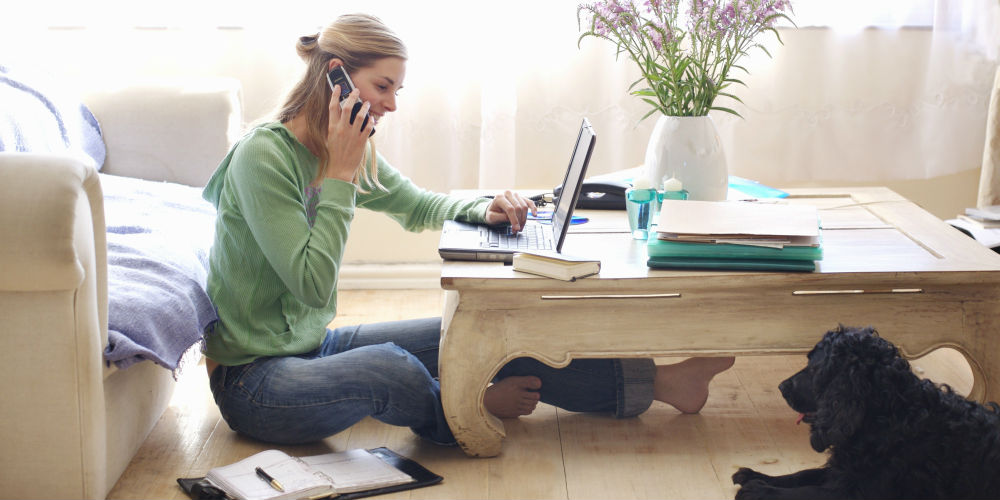The flexibility of working remotely is blissful…that is, until your kid pops up during a video call and the laundry starts giving you the stare-down. Whether working from home is your norm or just a sometime thing, experts share their best strategies to eliminate distractions and be your most productive self. What commute?
1 Stick to a Schedule
One of the pitfalls of working from home: working too much. Create a set schedule of total working hours that match your typical work-day. “When you have a structure, you become more efficient,” says Julie Morgenstern, an organizing expert and the author of Organizing from the Inside Out. Your start and stop times—and breaks—can be more fluid, but always finish at a designated time. “When there isn’t a specific cutoff time, it can be hard for people to step away from their work,” says Katharine Zaleski, cofounder and president of PowerToFly, a recruiting platform for remote and tech jobs for women.
2 Avoid the Couch…
With wireless, you can work anywhere—but just because you can doesn’t mean you should, says Morgenstern. “Designate a specific room or area so there’s a mental boundary between working and relaxing,” she suggests. If you don’t have a home office, figure out a space that has enough surface area for the nature of your work and that won’t lead to laptop neck and back strain. The dining room table is fine. Just make sure you clean up your work at the end of the day, with no stacks of papers around. “That way, work won’t bleed into family time,” says Morgenstern.
3 …And Make Your Work Space More Inviting
Once you’ve designated a space, keep it tidy. A cluttered work area can lead to cluttered thoughts, and at home, distractions are every- where. A pile of unopened mail will subconsciously nag you the whole day, so move it to a separate bin off your work space. “You don’t want your space to drain you—you want it to energize you,” says Morgenstern. “That doesn’t mean you need to be a neat worker. Just file papers away in boxes so you’re not staring at them.” Limit the stuff on your desk to whatever you’re working on at the moment and a few things that inspire you, like a piece of art or a plant that brings life into your space.
4 Don’t Do the Laundry
Doing chores, filing away bills, getting dinner ready—taking on household tasks throughout the day can eat up a ton of time and hurt your productivity. “Working from home doesn’t mean that you should be working on your home, and just because you’re home, you shouldn’t feel responsible to do these things throughout the day,” says Zaleski. If you do need a break to take care of some personal to-dos or cook dinner, schedule it on your calendar as you would any work appointment.
5 Set Up a System With Your Family
“Don’t kid yourself and think you don’t need a babysitter for young children if you’re working at home,” says Maura Thomas, a productivity expert and the author of Work Without Walls. With older kids, who can better understand boundaries while you’re working, come up with a sig- nal that lets them know you really can’t be disturbed: a closed door, a sign that says HARD WORK HAPPENING, or one of those business time clocks that say WILL RETURN AT 5 P.M. It can be difficult for kids to fight the urge to interrupt you. One idea, says Morgenstern, is to leave a chalk- board outside your door so your kids can write down what they need to talk to you about. “It removes the burden from them to remember later and lets you know what your kids need so you’re not blindsided when you’re done with work,” she says.
6 Have a Close-Out Ritual
The one benefit of a commute is that it gives you time to mentally switch gears from work to home life. When you only have a staircase separating you, you need a transition routine. Close out your to-do list, noting what you did and what to accomplish tomorrow. Then change your clothes. “We behave differently based on what we’re wearing,” says Morgenstern. When you work from home, you should get dressed into work clothes (not a suit but not yoga pants, she says). Then, once work is done, change into lounge clothes. “Your body will relax and know you’re in a different mode,” she says. Finally, have a plan for what you’re going to do once you’re finished with work. “You can only compete with the lure of sending one more email if you have a compelling alternative,” says Morgenstern, “whether it’s going for a walk, cooking dinner, or hanging with your kids.”













